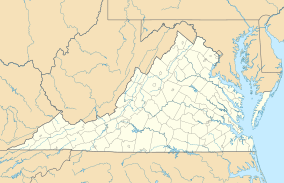Rich Hole Wilderness facts for kids
Quick facts for kids Rich Hole Wilderness |
|
|---|---|
|
IUCN Category Ib (Wilderness Area)
|
|
| Location | Virginia, United States |
| Area | 6,450 acres (26.1 km2) |
| Elevation | 3,400 ft (1,000 m) |
| Established | 1988 |
| Operator | George Washington and Jefferson National Forests |
| Website | George Washington and Jefferson National Forests – Rich Hole Wilderness Area |
The Rich Hole Wilderness is a special natural area in Virginia, United States. It's part of the George Washington and Jefferson National Forests. This wild place was created in 1988 and covers about 6,450 acres (26 km²). The United States Forest Service helps protect and manage it.
Contents
About the Rich Hole Wilderness
Rich Hole Wilderness is found about 16 miles (26 km) west of Lexington, Virginia. It is located near Interstate 64. The land here ranges from about 1,500 feet (457 m) to 3,500 feet (1,067 m) high.
The wilderness gets its name from the "drainage holes" in Brushy Mountain. Water from these areas, like the North Branch of Simpson Creek and Alum Creek, flows into the Calfpasture River. This river then joins the James River and eventually reaches the Chesapeake Bay.
History of the Wilderness Area
In 1984, a law called the Virginia Wilderness Act helped protect certain areas. Rich Hole Wilderness was one of these places. The law asked for a study on how new buildings might affect the air quality in these areas.
After the study, members of Virginia's government decided to make these areas official wilderness in 1988. This helped protect them even more.
In 2009, the Forest Service thought about making Rich Hole Wilderness even bigger. They wanted to add more land to its western side. This would help connect it to another wild area called Rough Mountain Wilderness.
Plants and Trees
Rich Hole Wilderness is home to some very old trees. You can find large white ash and northern red oak trees growing along a stream. These trees are part of an old-growth forest, which means they have been growing for a very long time without much human disturbance.
A part of Rich Hole Wilderness is also a National Natural Landmark. This special area in Rockbridge County was recognized in 1974. It's known for its amazing "cove" hardwood forest. This forest is well-protected and has incredibly large trees of many different kinds.
Wildlife in the Wilderness
Rich Hole Wilderness is a great place for animals. In 1958, experts suggested it should be a wild area because of its large population of black bears.
Many other animals also live here. You might see white-tailed deer, wild turkey, squirrels, grouse, raccoons, beavers, and rabbits. It's a busy place for wildlife!
Things to Do
Many people enjoy hunting in Rich Hole Wilderness. It is described as the most popular activity here.
Hiking is also a fun activity, especially for day trips. There are no loop trails, so you will either need two cars or plan to hike back the way you came.
The main trail is the Rich Hole Trail. From the north, it climbs steeply up the mountain. Then it goes down gently to the south end. This trail is about 5.5 miles (8.9 km) long. Be careful in spring, as there are many stream crossings on the southern part of the trail.
Another trail is the White Rock Tower Trail. This trail follows an old road that once led to a fire tower on Mill Mountain. It forms the southern edge of the wilderness area.


